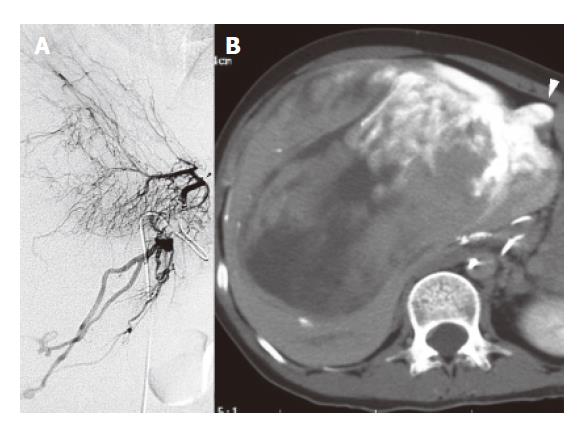Copyright
©2006 Baishideng Publishing Group Co.
World J Gastroenterol. Mar 7, 2006; 12(9): 1472-1475
Published online Mar 7, 2006. doi: 10.3748/wjg.v12.i9.1472
Published online Mar 7, 2006. doi: 10.3748/wjg.v12.i9.1472
Figure 1 Preoperative dynamic CT images.
A: plain; B: early phase; C: delayed phase; D: late phase. The tumor detected as a low demsity area and opputied the right hepatic lobe and the peritoneal cavity (A). Dynamic study revealed that the tumor enhanced irregularly at any phase (B-D).
Figure 2 Preoperative MRI images.
A: T1-weighted;B:fat-supressed T2-weighted;B and C: MR Cholangiography. The tumor appeared hypointense on T1-weighted images (A) and hyperintense on fat-suppressed T2-weighted images (B). MR cholangiography revealed that the tumor compressed the right lobe of the liver to the cranial side (C) and gallbladder to the medial-caudal side(arrow head:gallbladder) (D).
Figure 3 Preoperative angiography.
A: Hepatic arteriography; B: CT during cystic arteriography. Many arteries (i.e., right, middle, left hepatic, and subphrenic arteries fed the tumor (A) (arrow head:the root of cystic artery). However, CT during the selective cystic arteriography revealed stronger enhancement of the tumor than during any other arteriographies (B)(arrow head:gallbladder).
Figure 4 Resected specimen and histological findings.
A: Cutting section of the tumor; B: The main tumor; C: The edge of the tumor(hepatic side); D: The posterior wall of the gallbladder. The cutting section of the tumor appeared whitish solid and included parts of hemorrhage and necrosis and attached to the gallbladder firmly (A) (arrowhead: gallbladder). On histological examination, the tumor was mainly composed of spindle cells with cellular pleomorphism, and included lipoblasts (B). The tumor had a capsule (C), but the capsule annihilated a border of the gallbladder, where these tumor cells were detected in the muscle layer of the gallbladder (D).
- Citation: Hamada T, Yamagiwa K, Okanami Y, Fujii K, Nakamura I, Mizuno S, Yokoi H, Isaji S, Uemoto S. Primary liposarcoma of gallbladder diagnosed by preoperative imagings: A case report and review of literature. World J Gastroenterol 2006; 12(9): 1472-1475
- URL: https://www.wjgnet.com/1007-9327/full/v12/i9/1472.htm
- DOI: https://dx.doi.org/10.3748/wjg.v12.i9.1472












